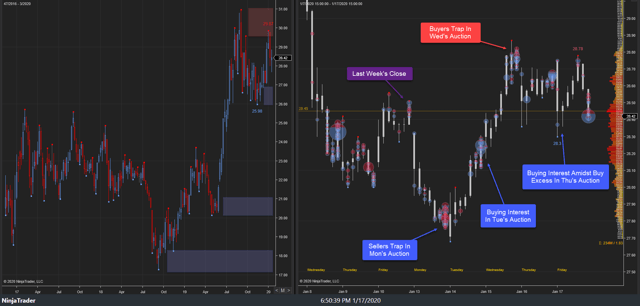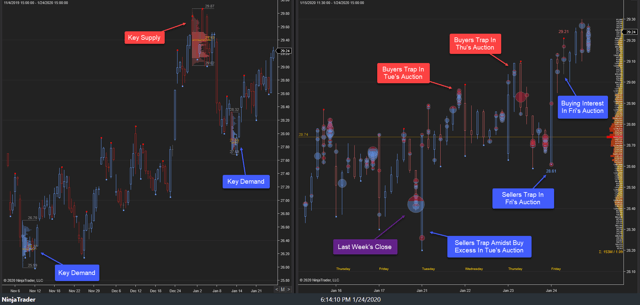In this article, we examine the significant weekly order flow and market structure developments driving NYSEARCA:GDX price action.
As noted in last week’s GDX Weekly, the highest probability path for this week was for price discovery higher. The primary expectation did play out as buy excess formed early week before price discovery higher developed and a buy-side breakout ensued mid-week above last week’s resistance. The breakout held as price discovery higher continued to 29.30s ahead of Friday’s close, settling at 29.22s.
21-24 January 2020:
This week’s auction saw minor price discovery lower early in Tuesday’s auction in a sell-side breakdown attempt below last week’s upper cluster, 28.90s-28.35s. Sellers trapped, 28.26s, amidst a buy excess that drove price higher back into prior balance. Price discovery higher ensued to 28.97s where buying interest emerged, 28.90s-28.96s, into Tuesday’s close. Tuesday’s late buyers failed to hold the auction as balance developed, 28.99s-28.65s, through Wednesday’s trade as the market churned at last week’s key resistance. Buying interest emerged again, 28.82s-28.85s, into Wednesday’s close.
Price discovery higher developed early in Thursday’s trade, achieving a stopping point, 29.10s. Buyers trapped there, driving price lower to 28.59s, testing the breakout area. Buy excess developed there as sellers trapped, 28.71s-28.74s, into Thursday’s close. A minor probe lower to 28.61s early in Friday’s trade saw sellers trap and price discovery higher resume as the breakout held. Price discovery higher developed, achieving the weekly stopping point high, 29.30s, ahead of Friday’s close, settling at 29.22s.
This week’s auction saw a failed sell-side breakdown below last week’s key support, 28.30s, before price discovery higher developed to 29.30s. Within the larger context, balance development continues, 31s-25.98s, following 2019’s rally.
Looking ahead, the focus into next week will center upon market response to this week’s unsecured high, 29.30s. Unsecured highs lack excess (rejection) usually indicating the trend has yet

